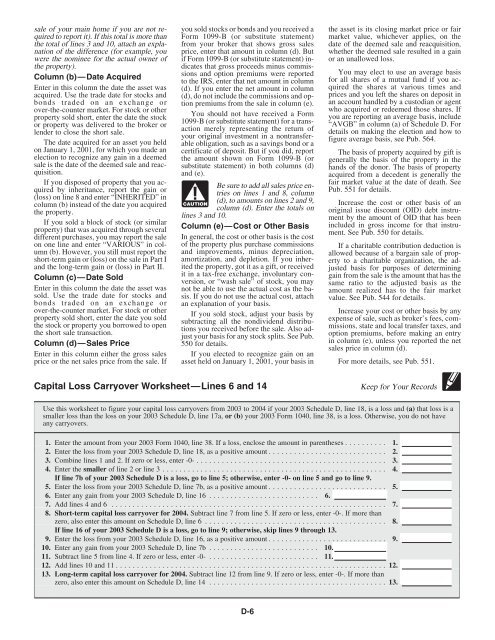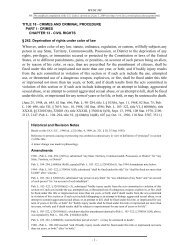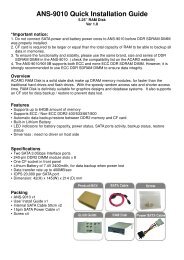2004 Instructions for Form 1040 (ALL) - Supreme Law Firm
2004 Instructions for Form 1040 (ALL) - Supreme Law Firm
2004 Instructions for Form 1040 (ALL) - Supreme Law Firm
You also want an ePaper? Increase the reach of your titles
YUMPU automatically turns print PDFs into web optimized ePapers that Google loves.
sale of your main home if you are not re- you sold stocks or bonds and you received a the asset is its closing market price or fair<br />
quired to report it). If this total is more than <strong>Form</strong> 1099-B (or substitute statement) market value, whichever applies, on the<br />
the total of lines 3 and 10, attach an expla- from your broker that shows gross sales date of the deemed sale and reacquisition,<br />
nation of the difference (<strong>for</strong> example, you price, enter that amount in column (d). But whether the deemed sale resulted in a gain<br />
were the nominee <strong>for</strong> the actual owner of if <strong>Form</strong> 1099-B (or substitute statement) in- or an unallowed loss.<br />
the property).<br />
dicates that gross proceeds minus commissions<br />
and option premiums were reported You may elect to use an average basis<br />
Column (b)—Date Acquired<br />
to the IRS, enter that net amount in column <strong>for</strong> all shares of a mutual fund if you ac-<br />
Enter in this column the date the asset was (d). If you enter the net amount in column quired the shares at various times and<br />
acquired. Use the trade date <strong>for</strong> stocks and (d), do not include the commissions and opan<br />
account handled by a custodian or agent<br />
prices and you left the shares on deposit in<br />
bonds traded on an exchange or tion premiums from the sale in column (e).<br />
over-the-counter market. For stock or other<br />
who acquired or redeemed those shares. If<br />
property sold short, enter the date the stock<br />
You should not have received a <strong>Form</strong> you are reporting an average basis, include<br />
or property was delivered to the broker or<br />
1099-B (or substitute statement) <strong>for</strong> a trans- “AVGB” in column (a) of Schedule D. For<br />
lender to close the short sale.<br />
action merely representing the return of details on making the election and how to<br />
your original investment in a nontransfer-<br />
The date acquired <strong>for</strong> an asset you held<br />
figure average basis, see Pub. 564.<br />
able obligation, such as a savings bond or a<br />
on January 1, 2001, <strong>for</strong> which you made an certificate of deposit. But if you did, report The basis of property acquired by gift is<br />
election to recognize any gain in a deemed the amount shown on <strong>Form</strong> 1099-B (or generally the basis of the property in the<br />
sale is the date of the deemed sale and reac- substitute statement) in both columns (d) hands of the donor. The basis of property<br />
quisition. and (e). acquired from a decedent is generally the<br />
If you disposed of property that you ac-<br />
Be sure to add all sales price enfair<br />
market value at the date of death. See<br />
quired by inheritance, report the gain or<br />
tries on lines 1 and 8, column<br />
Pub. 551 <strong>for</strong> details.<br />
(loss) on line 8 and enter “INHERITED” in<br />
(d), to amounts on lines 2 and 9,<br />
column (b) instead of the date you acquired<br />
Increase the cost or other basis of an<br />
column (d). Enter the totals on<br />
the property.<br />
original issue discount (OID) debt instru-<br />
lines 3 and 10.<br />
ment by the amount of OID that has been<br />
If you sold a block of stock (or similar<br />
Column (e)—Cost or Other Basis included in gross income <strong>for</strong> that instruproperty)<br />
that was acquired through several<br />
ment. See Pub. 550 <strong>for</strong> details.<br />
different purchases, you may report the sale In general, the cost or other basis is the cost<br />
on one line and enter “VARIOUS” in col- of the property plus purchase commissions If a charitable contribution deduction is<br />
umn (b). However, you still must report the and improvements, minus depreciation, allowed because of a bargain sale of propamortization,<br />
and depletion. If you inher-<br />
erty to a charitable organization, the adshort-term<br />
gain or (loss) on the sale in Part I<br />
and the long-term gain or (loss) in Part II. ited the property, got it as a gift, or received justed basis <strong>for</strong> purposes of determining<br />
Column (c)—Date Sold<br />
it in a tax-free exchange, involuntary con- gain from the sale is the amount that has the<br />
version, or “wash sale” of stock, you may same ratio to the adjusted basis as the<br />
Enter in this column the date the asset was not be able to use the actual cost as the ba- amount realized has to the fair market<br />
sold. Use the trade date <strong>for</strong> stocks and sis. If you do not use the actual cost, attach value. See Pub. 544 <strong>for</strong> details.<br />
bonds traded on an exchange or an explanation of your basis.<br />
over-the-counter market. For stock or other<br />
If you sold stock, adjust your basis by Increase your cost or other basis by any<br />
property sold short, enter the date you sold<br />
subtracting all the nondividend distributhe<br />
stock or property you borrowed to open<br />
expense of sale, such as broker’s fees, com-<br />
tions you received be<strong>for</strong>e the sale. Also adthe<br />
short sale transaction.<br />
missions, state and local transfer taxes, and<br />
just your basis <strong>for</strong> any stock splits. See Pub. option premiums, be<strong>for</strong>e making an entry<br />
Column (d)—Sales Price<br />
550 <strong>for</strong> details.<br />
in column (e), unless you reported the net<br />
sales price in column (d).<br />
Enter in this column either the gross sales If you elected to recognize gain on an<br />
price or the net sales price from the sale. If asset held on January 1, 2001, your basis in For more details, see Pub. 551.<br />
Capital Loss Carryover Worksheet—Lines 6 and 14<br />
Keep <strong>for</strong> Your Records<br />
Use this worksheet to figure your capital loss carryovers from 2003 to <strong>2004</strong> if your 2003 Schedule D, line 18, is a loss and (a) that loss is a<br />
smaller loss than the loss on your 2003 Schedule D, line 17a, or (b) your 2003 <strong>Form</strong> <strong>1040</strong>, line 38, is a loss. Otherwise, you do not have<br />
any carryovers.<br />
1. Enter the amount from your 2003 <strong>Form</strong> <strong>1040</strong>, line 38. If a loss, enclose the amount in parentheses .......... 1.<br />
2. Enter the loss from your 2003 Schedule D, line 18, as a positive amount ............................ 2.<br />
3. Combine lines 1 and 2. If zero or less, enter -0- ............................................. 3.<br />
4. Enter the smaller of line 2 or line 3 ..................................................... 4.<br />
If line 7b of your 2003 Schedule D is a loss, go to line 5; otherwise, enter -0- on line 5 and go to line 9.<br />
5. Enter the loss from your 2003 Schedule D, line 7b, as a positive amount ............................ 5.<br />
6. Enter any gain from your 2003 Schedule D, line 16 .......................... 6.<br />
7. Add lines 4 and 6 ................................................................. 7.<br />
8. Short-term capital loss carryover <strong>for</strong> <strong>2004</strong>. Subtract line 7 from line 5. If zero or less, enter -0-. If more than<br />
zero, also enter this amount on Schedule D, line 6 ........................................... 8.<br />
If line 16 of your 2003 Schedule D is a loss, go to line 9; otherwise, skip lines 9 through 13.<br />
9. Enter the loss from your 2003 Schedule D, line 16, as a positive amount ............................ 9.<br />
10. Enter any gain from your 2003 Schedule D, line 7b .......................... 10.<br />
11. Subtract line 5 from line 4. If zero or less, enter -0- .......................... 11.<br />
12. Add lines 10 and 11 ................................................................ 12.<br />
13. Long-term capital loss carryover <strong>for</strong> <strong>2004</strong>. Subtract line 12 from line 9. If zero or less, enter -0-. If more than<br />
zero, also enter this amount on Schedule D, line 14 .......................................... 13.<br />
D-6













